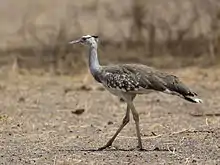| Arabian bustard | |
|---|---|
 | |
| Scientific classification | |
| Domain: | Eukaryota |
| Kingdom: | Animalia |
| Phylum: | Chordata |
| Class: | Aves |
| Order: | Otidiformes |
| Family: | Otididae |
| Genus: | Ardeotis |
| Species: | A. arabs |
| Binomial name | |
| Ardeotis arabs | |
| Synonyms | |
|
Otis arabs Linnaeus, 1758 | |

The Arabian bustard (Ardeotis arabs) is a species of bustard which is found across the Sahel region of Africa and south western Arabia. It is part of the large-bodied genus, Ardeotis, and, though little known, appears to be a fairly typical species in that group.
Taxonomy
In 1743 the English naturalist George Edwards included an illustration and a description of the Arabian bustard in his A Natural History of Uncommon Birds. Edwards' hand-coloured etching was based on a live specimen that had been kept by Hans Sloan at his house in London.[3] When in 1758 the Swedish naturalist Carl Linnaeus updated his Systema Naturae for the tenth edition, he placed the Arabian bustard with the other bustards in the genus Otis. Linnaeus included a brief description, coined the binomial name Otis arabs and cited Edwards' work.[4] The specific epithet arabs is Latin meaning "Arabian".[5] The Arabian bustard is now placed in the genus Ardeotis that was introduced in 1853 by the French naturalist Emmanuel Le Maout.[6][7]
Four subspecies are recognised:[7]
Description
As in all bustards, the male Arabian bustard is much larger than the female. Males have been found to weigh 5.7–10.9 kg (13–24 lb), while females weigh 4.5–7.7 kg (9.9–17.0 lb). The record-sized male Arabian bustard weighed 16.8 kg (37 lb). These birds stand from 70 cm (28 in) tall in females to 92 cm (36 in) tall in males.[8][9] They are fairly similar in overall appearance to the kori bustard, with a brown body, gray neck and white underside, but are noticeably smaller, with a more elegant, slender build. They are also differ in having white checkered covert pattern at the end of the folded wing, as opposed to various black-and-white patterns as seen in other large African bustards.[10]
Distribution and habitat
It occupies Semi desert and arid grassy plains, also "Acacia" woodlands.[11] It is found in Algeria, Burkina Faso, Cameroon, Chad, Djibouti, Eritrea, Ethiopia, Guinea-Bissau, Iraq, Kenya, Mali, Mauritania, Morocco, Niger, Nigeria, Saudi Arabia, Senegal, Somalia, Sudan, and Yemen.[12] It is a vagrant to Kenya, Gambia, northern Ivory Coast and northern Ghana.[1][11]

Behaviour and ecology
The Arabian bustard is usually solitary or lives in pairs and family parties. Small flocks have been observed migrating north into the Sahel zone, to breed during the rainy season before returning south when the dry season begins. However the population in Morocco was considered sedentary, as is the population in the Arabian Peninsula.[13] On these movements the Arabian bustard has been known to migrate with Denham's bustards.[11]
The clutch size of Arabian bustards is one to two eggs, laid in a shallow scrape on the ground. The females have sole responsibility for incubation of the eggs and rearing the young. When the brood is threatened, the females has been observed to demonstrate diversionary behaviour, e.g. calling, refusing to flee, to distract potential predators from chicks.[13]
Arabian bustards are reported to catch and eat locusts, grasshoppers, beetles, reptiles, and small mammals. They have also been recorded feeding on the seeds and fruits of shrubs, such as Cordia sinensis, Grewia villosa, Salvadora persica and wild melon Citrullus as well as "Acacia" gum.[13]
Conservation
Due to its wide range, it was not considered vulnerable by IUCN, although there is believed to have been a strong decrease in the population. In 2012 the species was uplisted to Near Threatened.[12] The primary cause of the decrease appears to be heavy hunting pressure, with habitat degradation and destruction also playing a major role.[1] The sedentary population recorded from Morocco, the subspecies A.a. lynesi, has not been definitely recorded since 1962, it is likely to be extinct.[1]
References
- 1 2 3 4 BirdLife International (2018). "Ardeotis arabs". IUCN Red List of Threatened Species. 2018: e.T22691924A129917069. doi:10.2305/IUCN.UK.2018-2.RLTS.T22691924A129917069.en. Retrieved 14 November 2021.
- ↑ "Appendices | CITES". cites.org. Retrieved 2022-01-14.
- ↑ Edwards, George (1743). A Natural History of Uncommon Birds. Vol. Part 1. London: Printed for the author at the College of Physicians. p. 12, Plate 12.
- ↑ Linnaeus, Carl (1758). Systema Naturae per regna tria naturae, secundum classes, ordines, genera, species, cum characteribus, differentiis, synonymis, locis (in Latin). Vol. 1 (10th ed.). Holmiae (Stockholm): Laurentii Salvii. p. 154.
- ↑ Jobling, James A. (2010). The Helm Dictionary of Scientific Bird Names. London: Christopher Helm. p. 53. ISBN 978-1-4081-2501-4.
- ↑ Le Maout, Emmanuel (1853). Histoire naturelle des oiseaux : suivant a classification de M. Isidore Geoffroy-Saint-Hilaire, avec l'indication de leurs moeurs et de leurs rapports avec les arts, le commerce et l'agriculture (in French). Paris: L. Curmer. p. 340.
- 1 2 Gill, Frank; Donsker, David; Rasmussen, Pamela, eds. (July 2021). "Turacos, bustards, cuckoos, mesites, sandgrouse". IOC World Bird List Version 11.2. International Ornithologists' Union. Retrieved 28 September 2021.
- ↑ Dunning, John B. Jr. (ed.) CRC Handbook of Avian Body Masses. CRC Press (1992), ISBN 978-0-8493-4258-5.
- ↑ Wood, Gerald (1983). The Guinness Book of Animal Facts and Feats. ISBN 978-0-85112-235-9.
- ↑ Stevenson, Terry and Fanshawe, John (2001). Field Guide to the Birds of East Africa: Kenya, Tanzania, Uganda, Rwanda, Burundi. Elsevier Science, ISBN 978-0856610790
- 1 2 3 Borrow, Nik; Demey, Ron (2001). Birds of Western Africa. A & C Black. ISBN 0-7136-3959-8.
- 1 2 "Recently recategorised species". Birdlife International (2012). Archived from the original on 14 September 2008. Retrieved 15 June 2012.
- 1 2 3 "Arabian Bustard Ardeotis arabs (Linnaeus 1758)". Sahara Conservation Fund. Retrieved 15 October 2016.
